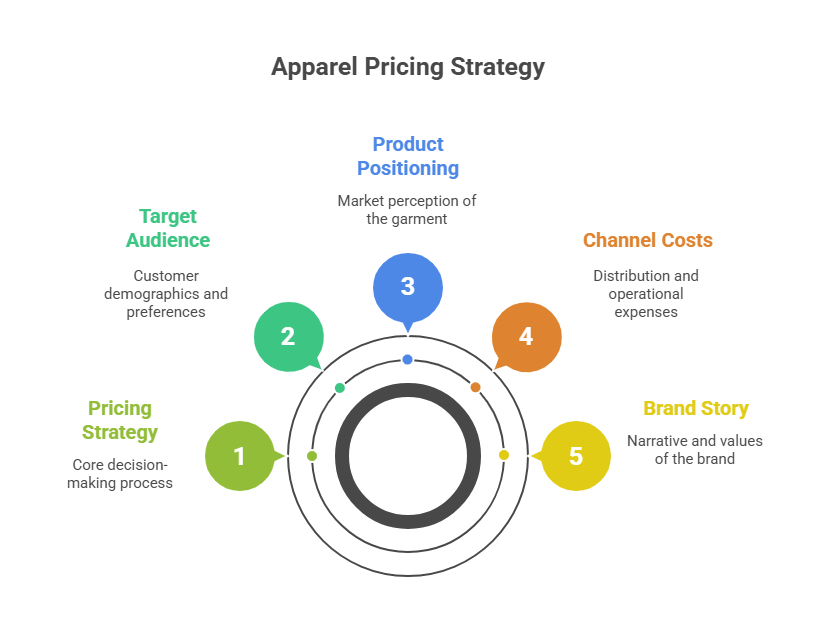Pricing Strategies in the Apparel Industry: What Works for Whom and Why
- Gaurav Mandal

- Jul 20
- 3 min read
Pricing is more than just assigning a value to a garment—it’s a signal of quality, brand positioning, and market segment. Whether you run a fast-fashion label, a D2C activewear startup, or a luxury couture house, your pricing strategy must align with your target audience, product positioning, channel costs, and brand story.
Let’s decode the most widely used pricing strategies in the apparel industry, with real-life Indian and global case studies for each.

1. Cost-Plus Pricing
Definition:
A markup is added to the production cost to ensure a fixed profit margin. Common in manufacturing-led or export-focused businesses.
Case Study 1: Shahi Exports (India)
Produces for global brands like H&M and Zara.
Adds a flat margin (10–15%) over production + logistics + compliance cost.
Works best due to stable production volumes and cost control.
Case Study 2: Classic Polo (Domestic Mass Market)
Manufactures in-house and sells through MBOs and LFS.
Uses a 2x markup from factory cost to MRP.
Keeps pricing affordable but ensures scale profitability.
Best for: Export houses, mass-market brands, wholesale sellers.
2. Value-Based Pricing
Definition:
Pricing based on perceived value to the customer, not just production cost. Ideal for premium and lifestyle brands.
Case Study 1: FabIndia
A cotton kurta that costs ₹400 to make is sold at ₹1,500+.
Justifies pricing through brand heritage, store experience, and artisanal value.
Case Study 2: Suta Bombay
Their sari prices reflect emotional storytelling, handloom narrative, and customer loyalty—not just the weave or dyeing cost.
Best for: D2C brands, craft-driven fashion, lifestyle-focused labels.
3. Dynamic Pricing
Definition:
Prices are adjusted based on demand, season, and inventory levels. Popular in e-commerce and omnichannel retail.
Case Study 1: Myntra
Prices fluctuate during sales, stockouts, or seasonal clearances.
AI tools suggest discounts based on click-through, carting, and conversion rates.
Case Study 2: Zivame (Lingerie)
Offers price drops during end-of-season sales and stock liquidation windows.
Tailors pricing dynamically by size and availability.
Best for: Marketplace brands, online fashion retailers, fast fashion.
4. Psychological Pricing
Definition:
Using pricing cues like ₹999 instead of ₹1000 to influence purchase decisions.
Case Study 1: Bewakoof
T-shirts priced at ₹399, ₹599—drives impulse buying among youth.
Anchors perception of affordability and trendiness.
Case Study 2: Allen Solly
Frequently prices products at ₹1,999 or ₹2,999 to stay under mental thresholds.
Common in malls and lifestyle stores.
Best for: Millennial-facing brands, mid-premium casualwear, impulse-driven categories.
5. Penetration Pricing
Definition:
Launching with low introductory pricing to capture market share quickly, and raising prices later.
Case Study 1: Snitch (Menswear D2C)
Launched with affordable, edgy streetwear at ₹499–₹699.
Later introduced higher-priced collections after gaining a fanbase.
Case Study 2: FableStreet (Workwear for Women)
Initial pricing under ₹1,200 for structured blouses to test traction.
Now commands ₹2,000+ pricing with elevated designs.
Best for: Startups, digital-first brands, new category entrants.
6. Premium or Prestige Pricing
Definition:
Set deliberately high to create exclusivity and luxury perception.
Case Study 1: Tarun Tahiliani (Bridal Couture)
Sarees start at ₹1.5 lakh+, justifying through embroidery techniques, craftsmanship, and bridal experience.
Case Study 2: RARE RABBIT
Positioned as India’s answer to Hugo Boss.
Prices formal menswear significantly higher than Van Heusen or Peter England, to reflect design and exclusivity.
Best for: Couture houses, luxury fashion, limited edition collections.
7. Bundle or Combo Pricing
Definition:
Selling multiple items at a discounted combo price to increase average order value (AOV).
Case Study 1: XYXX (Men’s Innerwear)
Offers 3-pack and 5-pack combos at attractive price points.
Improves volume and reduces per unit cost perception.
Case Study 2: Libas (Kurtas) on Amazon
Kurta sets bundled with dupattas or bottoms to justify higher ticket size and reduce returns.
Best for: Innerwear, valuewear, festival sets, accessories.
Conclusion: The Right Price is a Strategy, Not a Guess
In fashion, how you price is as important as what you sell. Pricing must reflect your brand promise, market position, and customer behavior.
Whether you are a boutique label, D2C disruptor, or luxury house, choose the right pricing strategy and adapt it across platforms and seasons.
“Your price tells your customer who you are before your design does.”
Comments